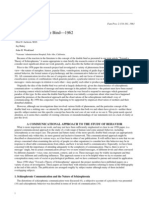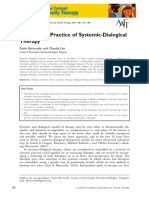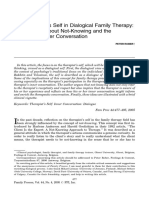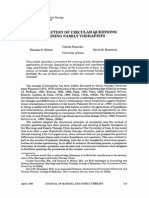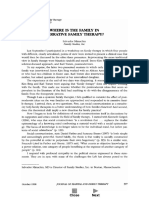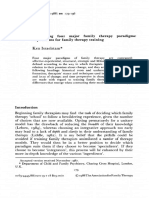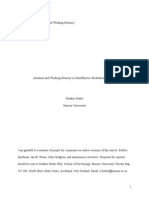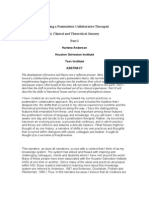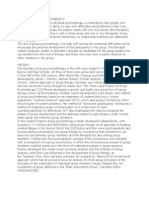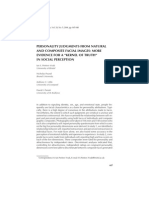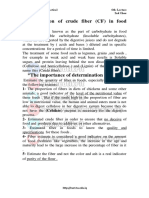Flaskas-2009-Australian and New Zealand Journal of Family Therapy
Flaskas-2009-Australian and New Zealand Journal of Family Therapy
Uploaded by
Camila OrellanaCopyright:
Available Formats
Flaskas-2009-Australian and New Zealand Journal of Family Therapy
Flaskas-2009-Australian and New Zealand Journal of Family Therapy
Uploaded by
Camila OrellanaOriginal Description:
Copyright
Available Formats
Share this document
Did you find this document useful?
Is this content inappropriate?
Copyright:
Available Formats
Flaskas-2009-Australian and New Zealand Journal of Family Therapy
Flaskas-2009-Australian and New Zealand Journal of Family Therapy
Uploaded by
Camila OrellanaCopyright:
Available Formats
Articles
The Therapist’s Imagination
of Self in Relation to Clients:
Beginning Ideas on the
Flexibility of Empathic Imagination
Carmel Flaskas
University of New South Wales, Australia
The therapist’s capacity to imagine is one specific par t of the endeavour of
empathy, which lies at the heart of the processes of the therapeutic relationship.
This article offers beginning ideas about the significance of therapist’s imagination
of self in relation to her/his clients in the task of trying to understand their experi-
ence. In seeking to ‘understand’ the experience of others, the therapist is able to
move between an imagination of sameness/identification with the client/s, and an
imagination of difference/‘foreignness’. The family therapy orientation of curiosity
and ‘not-knowing’ relies on the imagination of self as different to our clients; more
traditional understandings of empathic connection rely more heavily on the imagi-
nation of sameness/identification with clients. This article argues that flexibility in
the therapist’s use of self in moving between these positions allows an expanded
capacity for therapeutic connectedness. These ideas have special valence in the
practice territories of impasse and intercultural therapy.
Keywords: empathy, empathic imagination, therapist’s use of self, therapeutic relationship
This article offers a beginning set of ideas about the therapist’s imagination of self in
relation to her/his clients, which is one very specific part of the territory of empathy.
My topic is embedded in a broader interest in the therapeutic relationship, and in
the subtlety, richness and mutuality of connectedness between therapists and clients.
That the therapeutic relationship is enduring in its centrality to all forms of
psychotherapy is a claim that now scarcely needs to be argued. If evidence is required
An earlier version of this article was presented as a plenary contribution to the 29th Australian
Family Therapy Conference held in Brisbane, 2008.
Address for correspondence: Carmel Flaskas, Social Work, School of Social Sciences and International
Studies, University of New South Wales, UNSW Sydney 2052. E-mail: c.flaskas@unsw.edu.au
THE AUSTRALIAN AND NEW ZEALAND JOURNAL OF FAMILY THERAPY 147
Volume 30 Number 3 2009 pp. 147–159
Carmel Flaskas
beyond the everyday experience of practice, then one can turn to the well-established
empirical research program on the common factors that are related to positive
therapy outcomes across different practice modalities and therapeutic frameworks.
Study after study places the group of factors surrounding the therapeutic relationship
as central to therapy outcome, with an importance that comes second only to the
significance of the strengths and resources that clients bring with them to therapy
(Hubble et al., 1999; Sprenkle & Blow, 2004). In qualitative studies of clients’
experience, again and again, people comment on the importance of feeling that the
therapist understood them and their situation, or even just that the therapist tried
to understand.
The dynamic of empathy — of hoping to feel understood, on the one hand, and
trying to understand, on the other — can be complicated, with particular complex-
ities being generated in the modality of family therapy. The focus in this article is
specifically on empathic imagination and the therapist’s fantasy of self in relation to
other in orienting to the clients’ experiences, especially in family therapy. I am also
interested in different routes to therapeutic connectedness, as well as the flexibility
and balance of the therapist’s use of the imagination of self-in-relation-to-other in
the task of trying to understand. The exploration is structured in four parts. I will
begin by laying out some ideas about empathy and the context of family therapy
practice and theory. The second part will develop ideas about empathic imagina-
tion, and the significance of the kinds of fantasy of sameness or difference we use in
imagining ourselves in relation to our clients. This will be followed by a considera-
tion of flexibility and balance in our use of the imagination of self-in-relation-to-
other. The final section will gesture to two territories of practice potentially
enriched by these understandings — the challenge of impasse, and therapeutic
connectedness in intercultural relating.
Empathy in the Context of Family Therapy Theory and Practice
‘Empathy’ as a concept remains largely unclaimed in either the modernist or
postmodernist theory repertoires of family therapy. Yet, regardless of whether it is
theorised or not, empathy is a constant practice interplay. It is also an intensely
relational process. One simply cannot think of empathy in nonrelational terms, for
to do so would rip the idea out of the processes it attempts to describe. The process
(on the part of the therapist) of trying to understand exists only in relation to the
process (on the part of clients) of trying to convey experience and hoping to feel
understood. In this sense, empathy can only emerge in the intersubjective space
between therapist and clients.
The historical reluctance in family therapy to theorise the relational processes of
empathy is perhaps not so surprising. Empathy as a concept has been generated
largely in the context of the individual psychotherapies. Family therapy as a discipline
developed in the early 1960s and its boundary was delineated in opposition to the
enterprise of the individual psychotherapies, especially psychoanalysis. Family therapy
knowledge through to the 1980s was conceived within the modernist parameters of
its time — and, as one would expect, the individual psychotherapies of the time also
148 THE AUSTRALIAN AND NEW ZEALAND JOURNAL OF FAMILY THERAPY
The Flexibility of Empathic Imagination
existed within the same modernist parameters. Earlier psychoanalytic practices of
interpretation rested on the analyst’s capacity to name the unconscious experience
revealed by the patient. In client-centred practices, empathy was conceived as a
process of reflecting back to the client her or his experience in such a way that the
client could then recognise and know her or his experience more fully. In both these
earlier conceptualisations, one can see the ‘mirror’ image so characteristic of the
modernist project (Rorty, 1980), with something approaching ‘true’ knowledge about
the client’s experience being reflected back by the therapist.
Indeed, the ‘reflecting back’ technique of empathy developed in this period
became dominant in the Anglo-American contexts of counselling training, and is
still very influential in the contemporary (and more relational) texts on empathy
(see, for example, Pedersen, Crether and Carlson, 2008). As Ron Perry (1993)
notes, this dominance led to some confusion about whether the ‘reflecting back’
technique itself constituted the process of empathy, rather than being just one
particular way the therapist may engage in the attempt to reach for, and communi-
cate, some understanding of the client’s experience.
The practice of tentatively reflecting back thoughts and emotions in a therapeutic
conversation is very useful in the individual context of therapy. Even in this context,
though, reflecting back is just one possibility in the processes and expressions of
empathy. However, in family therapy, the reflecting-back technique of empathy was
neither commonly taught nor commonly used, even in the earlier modernist period,
more for reasons of practice than reasons of theory. A central practice issue in
working with families is that you do not just have one client and one therapist in the
room — you have a number of people in the room, with different voices and differ-
ent experiences. The task for the therapist of trying to understand, and trying to
convey some understanding, with different members of the family and to family as a
whole, necessarily becomes more complex and multilayered.
Moreover, trying to communicate empathy primarily through reflecting back
can be slow and quite repetitive, cutting across the liveliness and spontaneity that is
the freedom as well as the challenge of family work. Perhaps more importantly,
overt empathic reflections from the therapist to one particular member of the
family can sometimes cut across the task of trying to understand the differences of
people’s experiences in the family. Particularly in the early stages of the therapeutic
work, when family members are not at all sure whether the therapist will be able to
appreciate their different struggles, a too overtly understanding response to one
person can raise anxiety for other people in the family about your readiness and
capacity as a therapist to understand their situations and experiences.
For all these practice reasons, family therapy (in modernist and postmodernist
times) came to rely more heavily on questions and it is the use of questions that
constitutes one of the main concrete ‘in the room’ differences between individual
and family modalities in psychotherapy. Maybe precisely because questions do not
fit so neatly with the reflecting-back practices of empathy, the important empathic
function of questioning in building and holding therapeutic connectedness became
largely invisible.
THE AUSTRALIAN AND NEW ZEALAND JOURNAL OF FAMILY THERAPY 149
Carmel Flaskas
In one of the rare discussions of empathy in the family therapy literature, Perry
(1993) mapped the broader relational territory of empathy, drawing out the way
in which mainstream family therapy practices of questioning, reflecting teams,
therapeutic opinions and the use of tasks all hold the potential for the expression
of understanding and empathic communication. I would add to this list the
careful use of language that characterises the acknowledgment of family members’
emotions and predicaments — a habit one learns in family therapy is to use non-
aligning language, which can still powerfully acknowledge and nurture empathic
connection with individual members and the family as a whole.
Perry’s article was published in this journal in 1993, on the cusp of the transi-
tion to postmodernist parameters in family therapy, and it remains an enriching
and thorough consideration of empathy in work with families. Though ‘empathy’
(named as such) holds no special place in the later postmodernist family therapy
theory repertoire, nonetheless strands of work continue to explore the practice
territory of understanding and therapeutic connectedness in the therapeutic
process. David Pocock’s 1997 article ‘Feeling Understood in Family Therapy’ did
not invoke the concept of empathy yet, as its title suggests, it directly explores the
process of understanding, offering a finely grained discussion of the mutuality and
subtlety of the therapist’s attempts to understand and the client’s experience of
feeling understood. In the last decade, Pocock has continued to follow the trajec-
tory of exploring emotional systems in family therapy, with his writing increasingly
integrating contemporary ideas from relational psychoanalysis (see, e.g., Pocock
2005, 2009).
Psychoanalysis has provided the source of a number of other integrations that
are relevant to the processes of empathy in the systemic context. The idea of
containment in the therapeutic relationship has been explored by a number of
writers (Flaskas, 2002, 2005a; Gibney, 2003; Larner, 2000, 2009). Mary Donovan
(2005, 2009) has explored the resonance and difference of reflecting processes in
systemic therapy and psychoanalysis. The ‘set’ of ideas of transference, counter-
transference and projective identification has been used in rich explorations of
unconscious processes in family therapy (see, for example, Bland, 2009; Kraemer,
2009). I have also built on this set of ideas in the systemic context, arguing that
reflection employing these ideas provides a bridge to empathy, with the therapist
using her/his emotional reactions as one way of connecting to clients’ experience
(Flaskas, 2002, 2005a).
Coming from a different and more purely systemic location, Paolo Bertrando
and colleagues (Bertrando, 2007; Bertrando & Gilli, 2008; Bertrando & Arcelloni,
2009) are also exploring emotions and emotional systems in systemic therapy.
Glenda Fredman (2004) has developed ideas about the relational practices of
emotion and the ‘doing’ and ‘being-with’ in emotion. The work of Peter Rober
(1999, 2002, 2005) should be referenced here as well, again not because he writes
on empathy as such, but because his use of the dialogical perspective allows a very
rich space for thinking about emotions and the processes between therapist and
clients. Glenn Larner (2004, 2009) has recently been considering the ethical philos-
ophy of Levinas and the implications for how one might think about the face-to-
150 THE AUSTRALIAN AND NEW ZEALAND JOURNAL OF FAMILY THERAPY
The Flexibility of Empathic Imagination
face encounter in therapy. And while I am listing this much broader field of emerg-
ing contemporary systemic work that leans toward understandings of the relational
processes of empathy, I should also include much of the writing over the past 15
years on the therapeutic relationship in systemic therapy (see, e.g., Flaskas, Mason
& Perlesz, 2005).
Though space does not allow a fuller acknowledgment of these very different
strands of work, my discussion in this article sits within this broader milieu in
systemic family therapy theory. There are many ways in which the territory of
empathy may be approached, and my contribution is quite specific and sits side-by-
side these other offerings: here I will explore the therapist’s fantasy of self-in-
relationship and how this imagination folds into the processes of empathy.
Empathic Imagination and the Fantasy of Self-In-Relationship
In his study of psychoanalytic empathy, Stefano Bolognini (2004, p. 13) writes of
those ‘privileged moments’ that combine ‘emotion, imagination and reflection’.
Imagination lies at the heart of the attempt to understand. What it is we try to
understand emerges in the context of the therapy, and the sites of significance are
marked out in the clients’ lived experience as well as constructed and ‘unearthed’ in
the therapeutic conversation and therapeutic process. In family therapy, we gener-
ally try to imagine something about others’ experience, the place they come to
occupy in their intimate relationships and broader social systems, their emotional
experiences, the sense they (and others) might be making of their situation and
what they do in relation to all this. We often struggle for neutrality — and of course
I am not referring here to a flat engagement characterised by emotional distance,
but rather to an emotionally engaged and interested curiosity about all family
members, coupled with a scrupulous balance in trying to think about different
spots in the family system and about different people’s experiences.
Finding this balance is a discipline required in family therapy, more so than in
individual therapy. One could also think of it is as the discipline of forcing yourself
to remain open to thinking about all family members and their experiences. This is
often not such an easy thing, as routinely we relate more easily to some families and
not others, and to some family members and not others. If you like, we ‘recognise’
some people and their experience more easily than others in relation to ourselves.
Resonances flow very easily around gender, age, class, culture and race, sexuality,
emotional styles, ways of relating and life experiences.
Yet, even the first impulse of beginning to feel connected relies on imagination,
when we are imagining that we may be recognising some things about our clients’
experiences. When one thinks about imagining something, it is often easier to focus
on what it is we are trying to imagine and understand — in this case, trying to
imagine the experiences of the family and different family members. But let me
instead draw the attention here back one step further, for I would like to think
about the fantasy we have about ourselves in relation to our clients, and the position
we are imagining ourselves to be in relationship to others when we are trying to
understand their experience.
THE AUSTRALIAN AND NEW ZEALAND JOURNAL OF FAMILY THERAPY 151
Carmel Flaskas
In general, there are two kinds of positions we can use in imagining ourselves to
be in relationship to others, each relying on a different kind of fantasy of self-in-
relationship-to-other. The first is the fantasy of identification, which assumes that
we are sufficiently like the other to try to imagine ourselves in their situation, and
to use whatever resonances come from our own experience in orienting to our
clients’ experiences. This is the position evoked in the common expression ‘to put
yourself in someone else’s shoes’, and sometimes this phrase is itself used as an acces-
sible (if partial) definition of empathy.
The second position relies on another kind of relationship fantasy. Here, rather
than imagining ourselves as the same as, we imagine ourselves as ‘the other’. We
assume that we will not be able to make any easy sense of our clients’ experiences
and, instead, like an anthropologist in a different culture, or like a foreigner visiting
in a different society, we will need to be quite active if we are to try to grasp the
experience of the people we are sitting with. When I was learning techniques of
questioning in family therapy, our training supervisor said something like ‘think
Martian — imagine you have just landed on Planet Earth and that you cannot
easily make sense of what you are seeing and hearing: what questions would you
need to ask in order to make sense of this family’s experience?’.1
Another association I have here is to a specific moment in therapy. It happened
many years ago but, though I feel embarrassed admitting it, I was not new to
counselling and therapy and had a reasonable amount of experience in intercultural
work. I was sitting in a session in Sydney with a large Lebanese family and an inter-
preter when, amidst the general hubbub, a moment of clarity descended on me: I
thought ‘but I’m the one who is the foreigner here, it’s me who is the foreigner’.
That this self-evident observation came so belatedly in my professional life speaks to
my own lack of experience of myself as anything other than unselfconsciously ‘at
home’ — for then and now I continue to carry the kind of insularity that is the
legacy of a culturally and racially homogenous childhood. However, in that session I
did emotionally grasp, in a way that I had not done before, that to some extent all
psychotherapy is a cross-cultural experience, which is not to deny the chasms of
difference and its different significances in intercultural work. I also grasped that,
from one angle, it should be the therapist who thinks of her/himself as ‘other’ to the
client/s, rather than the reverse imagination of this relationship.
Over the years, I have found the ideas that emerged in these two moments in
my professional life to be liberating, in much the same way as I have found some of
the differences of family therapy practices to be liberating. Asking questions and
being curious and continuing to hold alongside different people in the room can be
fun. The discipline of forcing yourself to stay curious, to keep trying to understand
from a position that assumes you cannot easily understand the other allows one
form of connection, which contrasts to the form of connection made possible by
imagining that you should be able to understand the commonality of the other’s
experience with your own.
If one thinks of the practices of empathy that cluster around reflecting back, the
imaginative position of self-in-relationship is that of ‘identification-with’, and one
searches for commonality of experience. Then one can think of other practices,
152 THE AUSTRALIAN AND NEW ZEALAND JOURNAL OF FAMILY THERAPY
The Flexibility of Empathic Imagination
particularly in family therapy, where the discipline of curiosity demands a different
kind of fantasy of self-in-relationship, one where as therapist I assume that I am a
foreigner and cannot easily understand the difference of my clients.
In short, the imagination of sameness and identification is embedded in the tradi-
tional theorisations of empathy, and the imagination of difference and foreignness is
more embedded in some of the practices that have been developed in family therapy.
However, neither position is well theorised in understandings of empathy, and indeed
the empathic function of many of our practices in family therapy tends not to be
acknowledged in theory (or, indeed, in most practice) discussions.
Flexibility and Balance in the Imagination of Self-In-Relationship
It is important to stress that the two positions I have just drawn are not opposi-
tional, and that to use the imagination of self-as-different is not necessarily any
better than imagining the self-as-same-as for the purposes of empathic connection.
Though the nature of family therapy means that the imagination of difference is
required more routinely than in individual therapy, I would argue that the task of
empathic connection in any form of psychotherapy requires the flexibility of a back-
and-forth movement between the fantasy of sameness and the fantasy of difference.
My argument here, then, is that it is the flexibility of how as therapists we
imagine ourselves in relation to our clients that is one of the important ingredients
in the process of empathic connection. We try to imagine ourselves as-the-same-as,
to be open to exploiting all the resonances that clients’ experiences evoke in our
own experiences, and we hear what they say and we speak back from this imagina-
tion. We also try to imagine ourselves as different-to, assuming that even what
seems to be very similar to our own experience may in fact be very different. We
struggle to imagine what it may be like to inhabit our clients’ world of relating,
leaving open the possibility that the sense of those connections lies well outside our
experience — and we listen and speak back from this position of difference and
foreignness. Both positions are imaginations of connection and, interactionally, they
each have the effect of invitations to therapeutic connection and shared understand-
ings. However, each also offer forms of connection that the other position cannot
offer, and so the flexibility of using both positions provides the richest ground for
empathic relating.
This back-and-forth movement between these two positions is also used in
individual psychotherapy. One orients to sameness and then to difference and back
again, and the trick is to stay open to both kinds of imagination of self and client,
to allow both sameness and difference to be experienced and thought about. The
contribution from psychoanalysis and the ideas built around transference/counter-
transference and projective identification allows another layer of thinking again
about the use of self in the territory of connection. This set of ideas allows us to
orient to the way in which our self and our reactions and experiences in the process
of therapy help us think about communication and connection with clients in the
interests of generating empathic understandings. Psychoanalysis draws attention to
both conscious and unconscious processes in the therapeutic relationship, and to
THE AUSTRALIAN AND NEW ZEALAND JOURNAL OF FAMILY THERAPY 153
Carmel Flaskas
the extent to which our ability to experience projective processes, to take on board
some emotions from clients as an experience of self, and then to think about our
own experience in relation to our clients’ experience — all this allows a rich
connectedness. Of course, these ideas move one step beyond an idea of a purposeful
and conscious imagining of self-in-relationship to a more immediately intimate and
direct use of self.
There has been a tendency in some of the postmodern theorising to draw
dichotomous distinctions that collapse the complexity of therapeutic relating
(Flaskas, 2002). In particular, there has been a false dichotomy drawn between
subject and object, as if we either relate to our own (and our clients’) experience in
terms of a connected subjectivity or, instead, as a distant and separate object of
knowledge. Yet, to think about how we relate to our own experience, one of the
gifts of human consciousness is that we can relate to our own experience both from
within the agency of our subjectivity as well as from a position of reflecting on
ourselves as the object of experience. In short, we can be immersed in experience yet
still maintain a relationship to that experience. Understanding does indeed involve
‘emotion, imagination and reflection’ (Bolognini, 2004, p. 13) — for we are, at the
same time, both subject and object of our experience.
The dialectical relationship of subjectivity and objectivity is embedded in the
imagination of sameness and difference in our attempts at empathic relating in the
context of psychotherapy. The flexibility required in moving between the two is
more fluid when working with families, precisely because you are relating to a
number of people and not just one. And so, the discipline of ‘balance’ calls forth a
complexity and a movement in how we are relating to each person in the family, as
well as the family as a whole.
Precisely because we find the fantasy of identification easier with some members
and not others in a family, we try to extend our imagination of identification to the
people with whom we find it hard to identify. Simultaneously, we try to hold a
position of curiosity, based on an imagining of difference, to that which we find
more immediately familiar. Families whose experience is a long way away from our
own social and familial histories of relating require an empathic connection that
fantasises sameness as well as difference, and families whose experience immediately
resonates with our own histories require a curiosity that keeps us alive to under-
standing the differences of their family system and social context. Thus we use both
flexibility and balance in the imagination-of-self-in-relationship in the process of
nurturing and strengthening empathy and therapeutic connectedness.
Practice Territories
Theory ideas do not capture the richness of practice and there is tension in the relation-
ship of theory and practice. Many practice situations have been in my mind as I have
been writing this article, both nagging at me about the topic, as well as resonating with
the theory ideas as they have been developing. In particular, I have been thinking of
challenges in my own practice around therapeutic impasse, as well as many, many situa-
tions in supervision where we have been trying collectively to tackle the difficulties of
154 THE AUSTRALIAN AND NEW ZEALAND JOURNAL OF FAMILY THERAPY
The Flexibility of Empathic Imagination
impasse. Alongside this set of musings, I have been thinking of situations that bring
forward the joy and complexity of intercultural and interracial relating, and the
challenges of therapeutic connectedness in intercultural work. I will use this last part of
the article to gesture to the relationship of the ideas about empathic imagination and
the fantasy of self-in-relationship to these two practice territories.
There have been some direct discussions of impasse in the family therapy literature
(Flaskas, 2005b; Rober, 1999) and the frequent times in therapy when families and
therapist feel stuck in the process of change. I have described impasse as an interactional
constellation both within families, and between family and therapist (Flaskas, 2005b).
Impasse is, by its very nature, a difficult time emotionally, and patterns are generated
around frustration and hopelessness, and anger and blame and shame. As the therapist,
one is always part of this, and it is easy to feel rattled, or despairing, or simply just feel
bad about your lack of helpfulness. Sometimes when stakes are high — for example, in
situations of abuse or suicidality — the therapist has to tolerate dread and somehow
‘hold’ knowing the possibility of a serious outcome, while continuing to hold the hope
for a more positive outcome.
In these very messy situations, family members and therapists often get stuck in
rigid positions. Compassionate connections among family members and between
therapist and family can begin to break down. Narratives calcify, and it can be diffi-
cult to stay alive to other more hopeful possibilities and stories. Very significantly in
terms of the therapeutic relationship, one’s capacity as a therapist for empathic
connection is affected and often seriously compromised.
There are many ways of thinking about how one may usefully use one’s ‘self ’ as
a therapist in tackling impasse, and there are many practices to call on (see Flaskas,
2005b). However, to focus here just on empathic imagination, there are two
common patterns that can easily ‘set in’ during impasse. One pattern is to emotion-
ally distance yourself as therapist from the mess and fear of failure and to lose the
capacity to imagine a relationship of identity with the clients. At these points, in an
extreme form, you settle into an imagination of difference, but one where the
family is imagined to be foreign, rather than the more connecting imagination of
self-as-foreigner in relation to the family. When stuck in this position, we are still
quite able to develop theoretically sophisticated understandings of why the family is
in such a hopeless position. Yet, despite the accuracy or otherwise of these assess-
ments of failure, the effect can be antitherapeutic, as our lack of capacity for imagi-
nation of ourselves-in-relationship to our clients corrodes empathic connection with
the family.
The other pattern, so common in family work, is to fall into a polarised position
in our imagining of our relationship to different family members. For example, we
find ourselves being able to relate only from an imagination of identification/
sameness to the parents tormented by the spiral of their daughter’s self-destructiveness,
and we cannot free ourselves to connect with the suicidal young woman by imagining
ourselves in relation to her as-the-same-as or as-different-to. Or our hearts break for
the emotionally abused child, and our imagination of identification/sameness with the
child prevents us approaching understandings of her attachment to her abusive
THE AUSTRALIAN AND NEW ZEALAND JOURNAL OF FAMILY THERAPY 155
Carmel Flaskas
parent, and disallows empathic connection and the possibility of understandings of
the parent, however destructive her or his actions might be.2
These common patterns within-self can fuel ‘antitherapeutic sequences’ (Flaskas,
2005b) — that is, you find yourself relating to the family in a way that embeds
stuckness. The extremeness and polarisation that marks an imagination of self-in-
relationship to clients is sometimes ‘just’ our own personal reaction to the context
of impasse — or, if you like, it is ‘just’ our own countertransference. At other times,
the dismantling of the flexibility of our fantasy of being-in-relationship-with is
more of a parallel process, and we may be ‘showing’ the intensity of the family’s
experience as a projective process. In whatever way you theorise this, reflective
practice can help to free up empathic imagination, which in turn can help ‘hold’
families through difficult periods of stuckness.
Let me gesture now to the other area of practice that thinking about empathic
imagination folds into — intercultural therapeutic relating. Earlier I noted that all
psychotherapy is, to some extent, intercultural. However, the chasm and significance of
difference in intercultural and interracial therapeutic relating makes special demands on
empathic imagination. Though there are many things that could be said about intercul-
tural relating, here I simply want to think about the imagination therapists have
themselves in relation to clients when relating across worlds of difference in lived experi-
ence. It is this imagination that provides the ground from which we relate and invite
relationship, and it is hard to think of a practice context that is more demanding of a
disciplined balance and flexibility of empathic imagination.
Either the fantasy of identification/sameness or the fantasy of self-as-other/different
can quickly become intensely problematic if used without a back-and-forth movement
between the two. In general, it is better to try to imagine oneself as a foreigner rather
than one’s clients as foreign, as this leads to more emotionally connected and experi-
ence-near practices of curiosity. The therapeutic invitation here is an attempt to signal a
desire to understand and connect in the context of an acknowledgment of one’s
ignorance. However, if one skews too heavily to relying on a fantasy of self-as-other, it
can be hard to avoid an interactional slide, so that practices of curiosity begin to seem
experience-far, not experience-near; and the family and family members feel more
firmly constructed by you as the ‘other’. The imagination of identification and sameness
needs to be held closely alongside the fantasy of difference, a kind of constant scanning
for resonance, or a tentative but persistent drawing on what might be ‘like’ our clients’
experience in our own lived experience and repertoire of imagination.
In the reverse polarity, stubbornly holding onto an imagination of sameness,
without the constant counterbalance of the imagination of difference, can lead quite
simply to a failure to connect to the difference. In the situation where the therapist
is in the dominant cultural and racial position, this can lead to a pernicious closing
down of the space for recognising or appreciating difference and otherness. As
therapists, of course, we know that one does not need to be consciously and deliber-
ately harmful to set in train destructive effects.
Stephen Frosh (2002) uses the idea of the ‘incorrigibility of otherness’, that we can
never understand the otherness of the other, and that ‘otherness might be something
that we are compelled to stand in awe of, (and) not to make comprehensible’ (Frosh,
156 THE AUSTRALIAN AND NEW ZEALAND JOURNAL OF FAMILY THERAPY
The Flexibility of Empathic Imagination
2009, p. 187). Yet honouring the incorrigibility of otherness is perhaps most powerful
in the context of the contradictory relational hope of connection. When I think of the
particular joy and pleasure that can be generated in intercultural therapeutic relating,
it seems to me that this pleasure relates to the dialectics of incorrigible difference (on
the one hand) and human connectedness and identification (on the other). One small
but important part of this constellation is the imagination we have of ourselves in
relation to our clients in our attempts at empathic connection.
Conclusion
David Pocock (1997, p. 298) wrote as a conclusion to his article on understanding:
… feeling understood is more than just useful knowledge; more too than a better
story. It is an experience of being more known to and appreciated by others and,
through them, to a greater appreciation of oneself. It is a celebration of both our
common humanity and our differences.
My article has been concerned with the therapist’s task of trying to understand. I chose
to explore one very particular process in the therapist’s use of self in empathy, and that is
how as therapists we imagine ourselves to be in relation to our clients and the fantasies
we use of ourselves-in-relationship as we try to connect with our clients’ experience. I
contrasted the imagination of identification/sameness and the imagination of self-as-
other/difference, and the pathways these fantasies offer in our invitations to therapeutic
connection. The theory and practice of family therapy has been at the forefront of this
exploration, and a number of comments have addressed the specificity of the task of
trying to understand in the context of work with families versus individual therapy.
However, the argument for the need for flexibility and balance in the use of these two
positions of imagining carries across the activities of psychotherapy as a whole.
While theory is by its nature abstract, therapy practice is always specific and
embodied and very human. The relational processes of empathy lie at the centre of
practice, whether theorised or not. Yet theory can help us navigate practice, and
ideas about the therapist’s imagination of self-in-relationship may be used to shed
light on complexities of practice, including the territories of impasse and intercul-
tural therapeutic connection.
Endnotes
1 Let me belatedly thank Laurie MacKinnon for this metaphor.
2 Drawing on a qualitative study, Lorraine Tempel (2007) gives a fascinating account of
‘situational pathways’ to empathy, where workers find points of imaginative connec-
tion/identification to meet difficulties of empathic connection with mothers who are sole
parents at risk of physical abuse of their children.
References
Bertrando, P. (2007). The dialogical therapist. London: Karnac Books.
Bertrando, P., & Arcelloni, T. (2009). Anger and boredom: Unpleasant emotions in systemic
therapy. In C. Flaskas & D. Pocock (Eds.), Systems and psychoanalysis: Contemporary
integrations in family therapy (pp. 75–92). London: Karnac Books.
THE AUSTRALIAN AND NEW ZEALAND JOURNAL OF FAMILY THERAPY 157
Carmel Flaskas
Bertrando, P., & Gilli, G. (2008). Emotional dances: Therapeutic dialogues as embodied
systems. Journal of Family Therapy, 30, 362–373.
Bland, J. (2009). Working with unconscious processes: Psychoanalysis and systemic family
therapy. In C. Flaskas & D. Pocock (Eds.), Systems and psychoanalysis: Contemporary
integrations in family therapy (pp. 21–38). London: Karnac Books.
Bolognini, S. (2004). Psychoanalytic empathy. London: Free Association Books.
Donovan, M. (2005). Bridging the gap: Similarity and difference between psychoanalytic
and systemic therapeutic orientations. British Journal of Psychotherapy, 22, 227–242.
Donovan, M. (2009). Reflective processes and reflective functioning: Shared concerns and
challenges in systemic and psychoanalytic therapeutic practice. In C. Flaskas & D.
Pocock (Eds.), Systems and psychoanalysis: Contemporary integrations in family therapy (pp.
149–166). London: Karnac Books.
Flaskas, C. (2002). Family therapy beyond postmodernism: Practice challenges theory. Hove,
England: Brunner-Routledge.
Flaskas, C. (2005a). Psychoanalytic ideas and systemic therapy: Revisiting the question ‘why
bother?’ Australian and New Zealand Journal of Family Therapy, 26, 125–134.
Flaskas, C. (2005b). Sticky situations, therapy mess: On impasse and reflective practice. In
C. Flaskas, B. Mason & A. Perlesz (Eds.), The space between: Experience, context and
process in the therapeutic relationship (pp. 111–125). London: Karnac Books.
Flaskas, C., Mason, B., & Perlesz, A. (Eds.) (2005). The space between: Experience, context
and process in the therapeutic relationship. London: Karnac Books.
Fredman, G. (2004). Transforming emotion: Conversations in counselling and psychotherapy.
London: Whurr Publishers.
Frosh, S. (2002). After words: The personal in gender, culture and psychotherapy. London:
Palgrave.
Frosh, S. (2009). What does the Other want? In C. Flaskas & D. Pocock (Eds.), Systems and
psychoanalysis: Contemporary integrations in family therapy (pp. 185–202). London:
Karnac Books.
Gibney, P. (2003). The pragmatics of therapeutic practice. Buckingham, UK: Open University
Press.
Hubble, M.A., Duncan, B.L., & Miller, S.D. (Eds.). (1999). The heart and soul of change:
What works in therapy. Washington, DC: American Psychological Association.
Kraemer, S. (2009). Is there another word for it? Countertransference in family therapy. In
C. Flaskas & D. Pocock (Eds.), Systems and psychoanalysis: Contemporary integrations in
family therapy (pp. 39–56). London: Karnac Books.
Larner, G. (2000). Toward a common ground in psychoanalysis and family therapy: On
knowing not to know. Journal of Family Therapy, 22, 61–82.
Larner, G. (2004). Levinas: Therapy as discourse ethics. In T. Strong & D. Pare (Eds.),
Furthering talk: Advanced in the discursive therapies (pp. 15–32). New York: Kluwer
Academic.
Larner, G. (2009). Intersecting Levinas and Bion: The ethical container in psychoanalysis
and family therapy. In C. Flaskas & D. Pocock (Eds.), Systems and psychoanalysis:
Contemporary integrations in family therapy (pp. 203–220). London: Karnac Books.
Pedersen, P.D., Crether, H.C., & Carlson, J. (2008). Inclusive cultural empathy: Making
relationships central in counseling and psychotherapy. Washington, DC: American
Psychological Association.
158 THE AUSTRALIAN AND NEW ZEALAND JOURNAL OF FAMILY THERAPY
The Flexibility of Empathic Imagination
Perry, R. (1993). Empathy — still at the heart of therapy: The interplay of context and
empathy. Australian and New Zealand Journal of Family Therapy, 14, 63–74.
Pocock, D. (1997). Feeling understood in family therapy. Journal of Family Therapy, 19,
283–302.
Pocock, D. (2005). Systems of the heart: Evoking the feeling self in family therapy. In C.
Flaskas, B. Mason & A. Perlesz (Eds.), The space between: Experience, context and process
in the therapeutic relationship (pp. 127–139). London: Karnac Books.
Pocock, D. (2009). Working with emotional systems: Four new maps. In C. Flaskas & D.
Pocock (Eds.), Systems and psychoanalysis: Contemporary integrations in family therapy (pp.
93–110). London: Karnac Books.
Rober, P. (1999). The therapist’s inner conversation in family therapy practice: Some ideas
about the self of the therapist, therapeutic impasse and the process of reflection. Family
Process, 38, 209–28.
Rober, P. (2002). Constructive hypothesizing, dialogic understanding, and the therapist’s
inner conversation: Some ideas of knowing and not-knowing in the family therapy
session. Journal of Marital and Family Therapy, 28, 467–478.
Rober, P. (2005). Family therapy as a dialogue of living persons: A perspective inspired by
Bakhtin, Volosinov and Shotter. Journal of Marital and Family Therapy, 31, 385–397.
Rorty, R. (1980). Philosophy and the mirror of nature. Princeton, NJ: Princeton University Press.
Sprenkle, D.H., & Blow, A.J. (2004). Common factors and our sacred models. Journal of
Marital and Family Therapy, 30, 113–129.
Tempel, L. (2007). Pathways to the clinician’s experience of empathy in engaging single
mothers at risk for physical abuse of their children. Clinical Social Work, 35, 257–265.
THE AUSTRALIAN AND NEW ZEALAND JOURNAL OF FAMILY THERAPY 159
You might also like
- Systemic Ethics TextbookFrom EverandSystemic Ethics TextbookKristina S BrownNo ratings yet
- Frca Final Guide PDFDocument8 pagesFrca Final Guide PDFSuhas KapseNo ratings yet
- 1 Karl Tomm Part 1 One Perspective in The Milan Systemic Approach 2022Document13 pages1 Karl Tomm Part 1 One Perspective in The Milan Systemic Approach 2022Roxana BoangarNo ratings yet
- Wilderness Cluster Course 1Document47 pagesWilderness Cluster Course 1api-421743003No ratings yet
- A Note On The Double Bind-1962 - G Bateson, DD Jackson, J HaleyDocument4 pagesA Note On The Double Bind-1962 - G Bateson, DD Jackson, J Haleyatul_sports2005446No ratings yet
- Systemics: An Introduction - by Umberta Telfener and Luca CasadioDocument99 pagesSystemics: An Introduction - by Umberta Telfener and Luca CasadiochristopherkinmanNo ratings yet
- (2018) Developing A Working Model of Cross-Cultural Supervision - A Competence - and Alliance-Based FrameworkDocument11 pages(2018) Developing A Working Model of Cross-Cultural Supervision - A Competence - and Alliance-Based FrameworkJuan C amiloNo ratings yet
- 50.5 - Where Is The Family in Narrative Family TherapyDocument7 pages50.5 - Where Is The Family in Narrative Family TherapyJocelyn G. García R.No ratings yet
- History of Postmodernism and PsychotherapyDocument19 pagesHistory of Postmodernism and PsychotherapyEllia Waters100% (1)
- Common Principles of Couple Therapy 2012 Behavior TherapyDocument11 pagesCommon Principles of Couple Therapy 2012 Behavior TherapyAleexandra SuarezNo ratings yet
- DefinitionDocument5 pagesDefinitionEmma Taylor100% (1)
- Theory and Practice of Systemic-Dialogical Therapy PDFDocument14 pagesTheory and Practice of Systemic-Dialogical Therapy PDFFelipe SotoNo ratings yet
- SyllabusDocument6 pagesSyllabuschan2x james100% (1)
- The Challenge of Creating Dialogical Space.... Peter RoberDocument17 pagesThe Challenge of Creating Dialogical Space.... Peter RoberJosé BlázquezNo ratings yet
- The Therapist's Self in Dialogical Family TherapyDocument19 pagesThe Therapist's Self in Dialogical Family Therapypekana74No ratings yet
- Opening Hearts, Opening Minds: Therapeutic Group ConsultationFrom EverandOpening Hearts, Opening Minds: Therapeutic Group ConsultationNo ratings yet
- LUDEWIG - Reality and Construction in PsychotherapyDocument5 pagesLUDEWIG - Reality and Construction in Psychotherapyflicts99No ratings yet
- The Evolution of Circular Questions: Training Family TherapistsDocument15 pagesThe Evolution of Circular Questions: Training Family TherapistsAngelo SimoesNo ratings yet
- The Milan Approach - Roots and EvolutionDocument4 pagesThe Milan Approach - Roots and EvolutionVivir Sin ViolenciaNo ratings yet
- Rober, Family Therapy As A DialogueDocument33 pagesRober, Family Therapy As A DialogueMatias RiosNo ratings yet
- Reflexive QuestioningDocument20 pagesReflexive QuestioningSupportNo ratings yet
- Strategic Family SystemDocument80 pagesStrategic Family SystemAngelo SiagoNo ratings yet
- Hypothesizing, Circularity, and Neutrality Revisited: An Invitation To CuriosityDocument6 pagesHypothesizing, Circularity, and Neutrality Revisited: An Invitation To CuriosityAllison NataliaNo ratings yet
- FP Human Systems As Linguistic SystemsDocument15 pagesFP Human Systems As Linguistic SystemsEmilia MorosanNo ratings yet
- Environmental Trauma, Resiliency and Activism: Finding A Personal Healing Process Through Community EngagementDocument26 pagesEnvironmental Trauma, Resiliency and Activism: Finding A Personal Healing Process Through Community EngagementKat Dunn100% (1)
- An Example of Reflexivity in Reflective Work and Its ImplicationsDocument7 pagesAn Example of Reflexivity in Reflective Work and Its ImplicationsDianne AllenNo ratings yet
- Social 11 4287056252Document86 pagesSocial 11 4287056252smrutimehtaNo ratings yet
- Bridging Technical Eclecticism and Theoretical Integration: Assimilative IntegrationDocument15 pagesBridging Technical Eclecticism and Theoretical Integration: Assimilative IntegrationAntigoni100% (1)
- Carr (2016) How and Why Do Family and Systemic Therapies WorkDocument19 pagesCarr (2016) How and Why Do Family and Systemic Therapies WorksofiaNo ratings yet
- Sfbtnarr 2Document19 pagesSfbtnarr 2api-267074391No ratings yet
- Minuchin (1998) - Where Is The Family in Narrative Therapy - Donde Esta La Familia en Terapia NarrativaDocument116 pagesMinuchin (1998) - Where Is The Family in Narrative Therapy - Donde Esta La Familia en Terapia NarrativaPsic. Gustavo RamirezNo ratings yet
- 2 Karl Tomm Part II One Perspective in The Milan Approach 2022Document19 pages2 Karl Tomm Part II One Perspective in The Milan Approach 2022Roxana BoangarNo ratings yet
- Feed-Forward: Future Questions, Future MapsDocument8 pagesFeed-Forward: Future Questions, Future MapsNicole Prat CoghlanNo ratings yet
- Approaching Countertransference in Psychoanalytical SupervisionDocument33 pagesApproaching Countertransference in Psychoanalytical SupervisionrusdaniaNo ratings yet
- Systemic Therapy and The Influence of Postmodernism 2000Document8 pagesSystemic Therapy and The Influence of Postmodernism 2000macmat1No ratings yet
- The Journey Towards Digital Systemic Competence - Thoughts On Training Supervision and Competence EvaluationDocument22 pagesThe Journey Towards Digital Systemic Competence - Thoughts On Training Supervision and Competence Evaluationapi-626497212No ratings yet
- Deconstructing Agnes - Externalization in Systemic SupervisionDocument11 pagesDeconstructing Agnes - Externalization in Systemic SupervisionDaniela UrreaNo ratings yet
- Family Systems Theory, Attachment Theory, and CultureDocument23 pagesFamily Systems Theory, Attachment Theory, and Cultureazizah pangestikaNo ratings yet
- Family Therapy and Systemic PracticeDocument4 pagesFamily Therapy and Systemic PracticeUyên TrươngNo ratings yet
- Integrating ApproachesDocument6 pagesIntegrating Approachesjanettst2100% (1)
- The Externalising of The Problem and The Re-Authorizing of Lives and Relationships.Document19 pagesThe Externalising of The Problem and The Re-Authorizing of Lives and Relationships.Margaret HickeyNo ratings yet
- Key Systemic IdeasDocument20 pagesKey Systemic IdeaskartuteNo ratings yet
- McKenzie2006 - Queering Gender - Anima-Animus and The Paradigm of EmergenceDocument23 pagesMcKenzie2006 - Queering Gender - Anima-Animus and The Paradigm of EmergenceVasiliki100% (1)
- Contrasting Four Major Family Therapy ParadigmsDocument18 pagesContrasting Four Major Family Therapy ParadigmsDaniela UrreaNo ratings yet
- Attention and Working Memory in Mindfulness-Meditation PracticesDocument20 pagesAttention and Working Memory in Mindfulness-Meditation PracticesSu AjaNo ratings yet
- The Termination Phase: Therapists' Perspective On The Therapeutic Relationship and OutcomeDocument13 pagesThe Termination Phase: Therapists' Perspective On The Therapeutic Relationship and OutcomeFaten SalahNo ratings yet
- FT and Systemic PracticeDocument4 pagesFT and Systemic PracticeAndra AndruNo ratings yet
- Becoming A Postmodern TherapistDocument31 pagesBecoming A Postmodern TherapistManuel Enrique Huertas RomanNo ratings yet
- Circular Questioning As A Therapeutic ToDocument13 pagesCircular Questioning As A Therapeutic ToNicole Prat CoghlanNo ratings yet
- The Role of The Imagination in An Analysis of Unconscious RelatednessDocument12 pagesThe Role of The Imagination in An Analysis of Unconscious RelatednessMal CruxNo ratings yet
- The Evolution of Circular Questions: Training Family TherapistsDocument15 pagesThe Evolution of Circular Questions: Training Family TherapistsravhcolNo ratings yet
- Family Life Cycle Developmental Stages 2Document31 pagesFamily Life Cycle Developmental Stages 2virupakshaNo ratings yet
- Psychological Testing Report-1Document80 pagesPsychological Testing Report-1Laveeza Khurram100% (1)
- (Gergen, 1985) The Social Constructionist Movement in Modern Psychology PDFDocument10 pages(Gergen, 1985) The Social Constructionist Movement in Modern Psychology PDFGiselaNo ratings yet
- The Double Bind TheoryDocument8 pagesThe Double Bind TheorynorahyiNo ratings yet
- What Is Group PsychotherapyDocument4 pagesWhat Is Group PsychotherapyLeah Sarah delos SantosNo ratings yet
- Gestalt TherapyDocument2 pagesGestalt TherapyjessicaNo ratings yet
- Basic Genogram SymbolsDocument118 pagesBasic Genogram SymbolsDuduzile Nongalewa100% (1)
- Swaby, Helen (2020) - Learning To 'Live Upside Down' - Experiencing The True and False Self in Psychotherapy TrainingDocument15 pagesSwaby, Helen (2020) - Learning To 'Live Upside Down' - Experiencing The True and False Self in Psychotherapy TrainingPaul CNo ratings yet
- Class12 Psychology Unit05 NCERT TextBook EnglishEditionDocument17 pagesClass12 Psychology Unit05 NCERT TextBook EnglishEditionDhave ManzanoNo ratings yet
- Transforming the Legacy: Couple Therapy with Survivors of Childhood TraumaFrom EverandTransforming the Legacy: Couple Therapy with Survivors of Childhood TraumaNo ratings yet
- Patch WorkDocument1 pagePatch WorkCamila OrellanaNo ratings yet
- Narrative TherapyDocument11 pagesNarrative TherapyCamila Orellana100% (1)
- Exploring Feminist Narrative Practice and Ethics in A School SettingDocument11 pagesExploring Feminist Narrative Practice and Ethics in A School SettingCamila OrellanaNo ratings yet
- Experiencia Del TerapeutaDocument23 pagesExperiencia Del TerapeutaCamila OrellanaNo ratings yet
- From Disorder To Political ActionDocument16 pagesFrom Disorder To Political ActionCamila OrellanaNo ratings yet
- WDM System DescriptionDocument68 pagesWDM System DescriptionRandy Dookheran80% (5)
- Ch06 Job, Batch and Service CostingDocument3 pagesCh06 Job, Batch and Service CostingAndrew ChongNo ratings yet
- Personality Judgments From Natural and Composite Facial Images: More Evidence For A "Kernel of Truth" in Social Perception.Document35 pagesPersonality Judgments From Natural and Composite Facial Images: More Evidence For A "Kernel of Truth" in Social Perception.InterestingScienceNo ratings yet
- MIL M3432 Cable SpecificationsDocument10 pagesMIL M3432 Cable Specificationschangiz22200% (1)
- Reliance Jaiprakash Hydro Propsosed Acquisition AnalysisDocument4 pagesReliance Jaiprakash Hydro Propsosed Acquisition AnalysisAbhilash ShahNo ratings yet
- Advances Baking ThaineDocument2 pagesAdvances Baking ThaineNicholas gwiniNo ratings yet
- Fitbit Versa 3 User ManualDocument92 pagesFitbit Versa 3 User Manualp-j-wNo ratings yet
- Mep 946 SP-1Document3 pagesMep 946 SP-1RECAMBIOSYMAQUINASCOMNo ratings yet
- Mock Topics 9-20 TestDocument11 pagesMock Topics 9-20 Testa_s_1_5No ratings yet
- Corded Ware YamnayaDocument47 pagesCorded Ware YamnayaJonNo ratings yet
- Officiating BadmintonDocument4 pagesOfficiating BadmintonKeish Zyron AlcarazNo ratings yet
- Comparative and Superlative AdjectivesDocument10 pagesComparative and Superlative AdjectivesAlejandra VegaNo ratings yet
- Sample Design-Build Contract Documents: Appendix 3Document1 pageSample Design-Build Contract Documents: Appendix 3mayasNo ratings yet
- Notes CorrosionDocument30 pagesNotes CorrosionShivam GuptaNo ratings yet
- Photoelectric Detector: Atsumielectric Co.,LtdDocument12 pagesPhotoelectric Detector: Atsumielectric Co.,LtdnastrapuleagraniceruNo ratings yet
- Determination of Crude Fiber (CF) in Food SampleDocument4 pagesDetermination of Crude Fiber (CF) in Food SampleFood InformationNo ratings yet
- Team Building For Youth Organization: CWTS - Civic Welfare Training Service Units: 3.0Document4 pagesTeam Building For Youth Organization: CWTS - Civic Welfare Training Service Units: 3.0Jon Aragasi100% (1)
- Chapter IVDocument11 pagesChapter IVHazel Kiah RasucayNo ratings yet
- Deformation SurveysDocument6 pagesDeformation SurveysKristina NewtonNo ratings yet
- Royer - A Switching Transistor D-C To A-CDocument5 pagesRoyer - A Switching Transistor D-C To A-CAnonymous keAMIVNo ratings yet
- Seismic Base IsolationDocument23 pagesSeismic Base IsolationMia Hussain100% (3)
- Practical Research 2: Grade 12 Learning Module First QuarterDocument19 pagesPractical Research 2: Grade 12 Learning Module First QuarterItsClarenceNo ratings yet
- Chapter 1Document29 pagesChapter 1Jagriti DhatwaliaNo ratings yet
- GRADE X - Science Lab Manual - CARBON DIOXIDE IS RELEASED DURING RESPIRATIONDocument4 pagesGRADE X - Science Lab Manual - CARBON DIOXIDE IS RELEASED DURING RESPIRATIONMoghanNo ratings yet
- Anicare 22032022Document35 pagesAnicare 22032022Suraj GantayatNo ratings yet
- Speech LabDocument1 pageSpeech LabScholarship LetterNo ratings yet
- School Site Development PlanDocument3 pagesSchool Site Development PlanMayShael baynosaNo ratings yet




